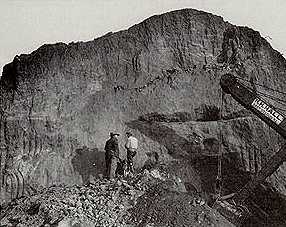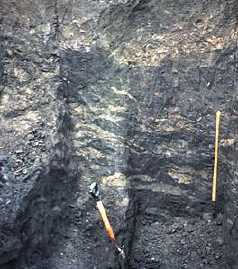
Destruction of Powell Mound showing stratigraphic .
zones indicative of different phases of mound construction.
For most American Bottom mounds we have little more than this very general understanding of mound construction, however. Work on the largest mound in North America, Monks Mound, for example, has been limited to a few excavations on platform surfaces (Benchley 1975), the Reed, Bennet and Porter (1968) solid cores, and testing of areas near the 1984 slump of the east face (McGimsey and Wiant 1984). Although limited, these studies hint at the wealth of information contained in the remaining mounds. Benchley, for example, has shown that additional thin layers of earth were added, perhaps on a yearly basis, to the conical mound on the first platform. This construction history is suggestive of a yearly renewal ritual.

Basketloading in Monks Mound profile.